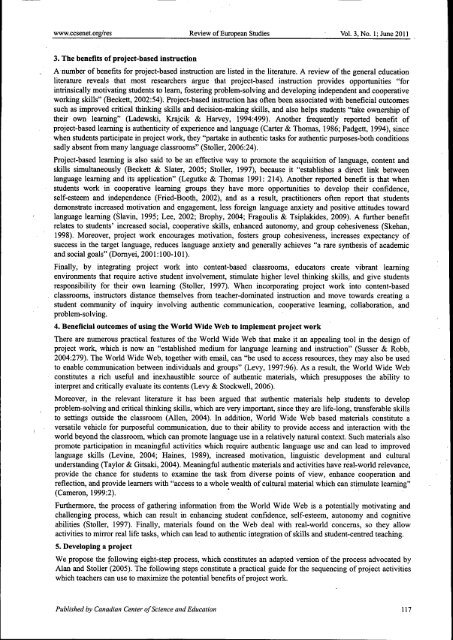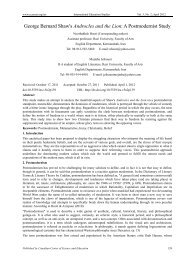Literature Review Sample #2 - ELSRU
Literature Review Sample #2 - ELSRU
Literature Review Sample #2 - ELSRU
Create successful ePaper yourself
Turn your PDF publications into a flip-book with our unique Google optimized e-Paper software.
www.ccsenet.org/res <strong>Review</strong> of European Studies Vol. 3, No. 1; June 2011<br />
3. The benefits of project-based instruction<br />
A number of benefits for project-based instmction are listed in the literature. A review of the general education<br />
literature reveals that most researchers argue that project-based instmction provides opportunities "for<br />
intrinsically motivating students to leam, fostering problem-solving and developing independent and cooperative<br />
working skills" (Beckett, 2002:54). Project-based instmction has often been associated with beneficial outcomes<br />
such as improved critical thitiking skills and decision-making skills, and also helps students "take ownership of<br />
their own learning" (Ladewski, Krajcik & Harvey, 1994:499). Another frequently reported benefit of<br />
project-based leaming is authenticify of experience and language (Carter & Thomas, 1986; Padgett, 1994), since<br />
when students participate in project work, they "partake in authentic tasks for authentic purposes-both conditions<br />
sadly absent from many language classrooms" (Stoller, 2006:24).<br />
Project-based leaming is also said to be an effective way to promote the acquisition of language, content and<br />
skills simultaneotisly (Beckett & Slater, 2005; Stoller, 1997), because it "establishes a direct link between<br />
language leaming and its application" (Legutke & Thomas 1991: 214). Another reported benefit is that when<br />
students work in cooperative leaming groups they have more opportunities to develop their confidence,<br />
self-esteem and independence (Fried-Booth, 2002), and as a result, practitioners often report that students<br />
demonstrate increased motivation and engagement, less foreign language anxiefy and positive attitudes toward<br />
language leaming (Slavin, 1995; Lee, 2002; Brophy, 2004; Fragoulis & Tsiplakides, 2009). A ftirther benefit<br />
relates to students' increased social, cooperative skills, enhanced autonomy, and group cohesiveness (Skehan,<br />
1998). Moreover, project work encourages motivation, fosters group cohesiveness, increases expectancy of<br />
success in the target language, reduces language anxiefy and generally achieves "a rare synthesis of acadetnic<br />
and social goals" (Domyei, 2001:100-101).<br />
Finally, by integrating project work into content-based classrooms, educators create vibrant leaming<br />
envirotiments that require active student involvement, stimulate higher level thinking skills, and give students<br />
responsibilify for their own leaming (Stoller, 1997). When incorporating project work into content-based<br />
classrooms, instmctors distance themselves from teacher-dominated instmction and move towards creating a<br />
student communify of inquiry involving authentic communication, cooperative ieaming, collaboration, and<br />
problem-solving.<br />
4. Beneficial outcomes of using the World Wide Web to implement project work<br />
There are numerous practical features of the World Wide Web that make it an appealing tool in the design of<br />
project work, which is now an "established medium for language leaming and instmction" (Susser & Robb,<br />
2004:279). The World Wide Web, together with email, can "be used to access resources, they may also be used<br />
to enable communication between individuals and groups" (Levy, 1997:96). As a result, the World Wide Web<br />
constitutes a rich useful and inexhaustible source of authentic materials, which presupposes the abilify to<br />
interpret and critically evaluate its contents (Levy & Stockwell, 2006).<br />
Moreover, in the relevant literature it has been argued that authentic materials help students to develop<br />
problem-solving and critical thinking skills, which are very important, since they are life-long, transferable skills<br />
to settings outside the classroom (Allen, 2004). In addition. World Wide Web based materials constitute a<br />
versatile vehicle for purposeftil communication, due to their abilify to provide access and interaction with the<br />
world beyond the classroom, which can promote language use in a relatively natural context. Such materials also<br />
promote participation in meaningful activities which require authentic language use and can lead to improved<br />
language skills (Levine, 2004; Haines, 1989), increased motivation, linguistic development and cultural<br />
understanding (Taylor & Gitsaki, 2004). Meaningful authentic materials and activities have real-world relevance,<br />
provide the chance for students to examine the task from diverse points of view, etihance cooperation and<br />
refiection, and provide leamers with "access to a whole wealth of cultural material which can stimulate leaming"<br />
(Cameron, 1999;2).<br />
Furthermore, the process of gathering information from the World Wide Web is a potentially motivating and<br />
challenging process, which can result in enhancing student confidence, self-esteem, autonomy and cognitive<br />
abilities (Stoller, 1997). Finally, materials found on the Web deal with real-world concems, so they allow<br />
activities to mirror real life tasks, which can lead to authentic integration of skills and student-centred teaching.<br />
5. Developing a project<br />
We propose the following eight-step process, which constitutes an adapted version of the process advocated by<br />
Alan and Stoller (2005). The following steps constitute a practical guide for the sequencing of project activities<br />
which teachers can use to maximize the potential benefits of project work.<br />
Published by Canadian Center of Science and Education 117





